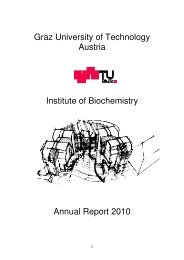Staff Members of the Institute of Biochemistry, TU - Institut für ...
Staff Members of the Institute of Biochemistry, TU - Institut für ...
Staff Members of the Institute of Biochemistry, TU - Institut für ...
You also want an ePaper? Increase the reach of your titles
YUMPU automatically turns print PDFs into web optimized ePapers that Google loves.
HO<br />
R 1<br />
H<br />
R 2<br />
HSO 4 -<br />
Inversion<br />
H<br />
R 1<br />
OH -<br />
O<br />
11<br />
R 2<br />
SO 3 -<br />
OH -<br />
HSO 4 -<br />
Retention<br />
Despite <strong>the</strong> differences in substrate preference and stereochemistry, <strong>the</strong> overall structure <strong>of</strong> this<br />
novel enzyme (termed Pisa1 = Pseudomonas inverting sulfatase) is virtually identical to <strong>the</strong><br />
previously determined structure <strong>of</strong> SdsA1. However, <strong>the</strong> active site <strong>of</strong> Pisa1 features several<br />
conspicuous amino acid exchanges (see figure below: in blue active side residues in SdsA1 and<br />
green those in Pisa1).<br />
Phe/Gly Tyr/His<br />
Ala/Ile<br />
These amino acids are now subject <strong>of</strong> an extensive mutagenesis program to define <strong>the</strong>ir role in<br />
governing substrate preference and <strong>the</strong> stereochemical course <strong>of</strong> <strong>the</strong> reaction. This project is a<br />
close collaboration with Pr<strong>of</strong>s. Faber (biocatalysis) and Wagner (structure determination) from <strong>the</strong><br />
University <strong>of</strong> Graz (<strong>the</strong>sis project <strong>of</strong> Tanja Knaus in our laboratory and Markus Schober in Pr<strong>of</strong>.<br />
Faber’s laboratory).<br />
Doctoral <strong>the</strong>ses completed<br />
Tyr/Ser<br />
Met/Ser<br />
Met/Ser<br />
Tyr/Ser<br />
Leu/Pro<br />
Sonja Sollner: Function and mechanism <strong>of</strong> Lot6p from Saccharomyces cerevisiae, a flavindependent<br />
quinone reductase<br />
Flavin-dependent NAD(P)H:quinone oxidoreductases have been reported from several<br />
mammalian sources. These enzymes have been thought to have a protective effect against<br />
quinone-related oxidative cell damage through <strong>the</strong>ir unique ability to transfer two electrons to a<br />
H<br />
R 1<br />
Ala/Ile<br />
OH<br />
R2














